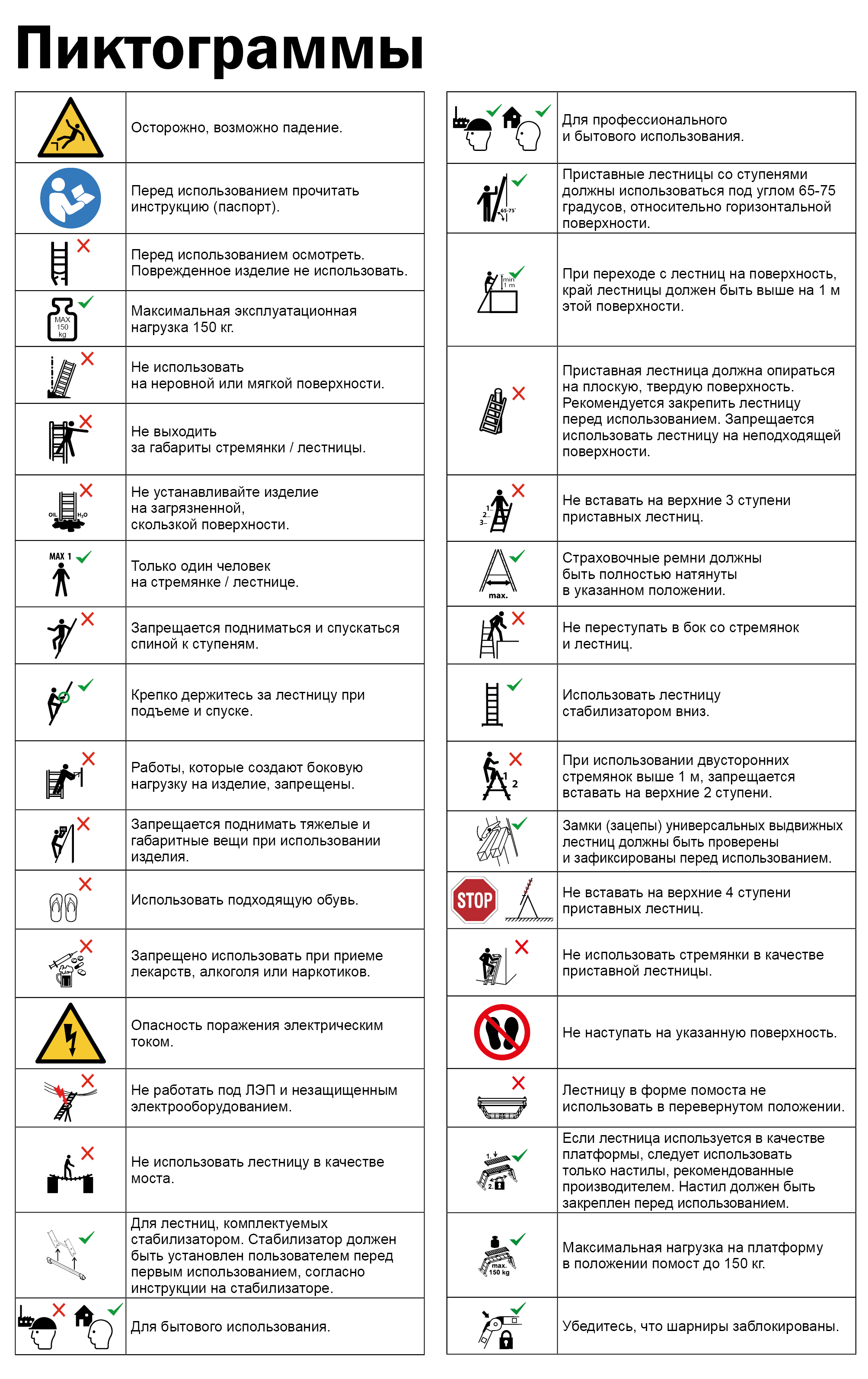Choose a suitable ladder. It should have the right length and be appropriate for the work being conducted. Check that this particular ladder is appropriate for this particular task.
Make sure that your physical condition allows you to work at height. Remember that any work at height always involves additional danger.
Familiarize yourself with the Ladder Passport and the Safety Measures.
Inspect the ladder carefully and confirm that it has no defects or deformations. Check the presence and working order of all components and joints of the ladder.
The maximum allowable load on the ladder is 150 kg. The ladder is to be used by one person only.
It is not recommended:
- to work on the ladder under the influence of alcohol and drugs, as well as while taking potent medications;
- to use a damaged ladder and a ladder with deformed elements;
- to independently repair the ladder and change its design.
The application instructions for professional ladders should be provided in accordance with the countryпїЅs laws. For Russia, the applicable documents are пїЅOccupational Safety Instructions when Working at HeightпїЅ, approved by the Order of the Labor Ministry of Russia dated 28.03.2014 No. 155пїЅ http://docs.cntd.ru/document/499087789, and SNiP III-4-80 пїЅSafety Measures in ConstructionпїЅ http://docs.cntd.ru/document/5200088.
In short, it means that only specially trained people with a certain level of expertise and familiar with special safety instructions for this particular type of work are allowed to work at heights, and such people are obliged to put their signature in the training record book. The location of high-rise operations should be enclosed and marked with a special colored tape (usually a black and yellow tape and in some dangerous cases - red and white).
In especially dangerous cases, a supervisor is additionally placed below. Everything is defined in the regulatory documents: what heights require harnesses, in which cases the ladder should be additionally secured, how weather conditions, wind loads and even time of the year should be taken into account, etc.
However, these instructions are applicable not only to professionals; they are intended for private users as well, because security measures are the same for everyone. They cannot be different in essence.A private user will have to become both a chief safety engineer and a contractor at the same time. Therefore, we strongly advise you to study these two core documents.
Remember that any work at height is always fraught with additional danger not only for the worker, but also for his family members who may happen to be in the danger zone, which in both cases can result in serious injuries.
Here are some basic rules for working with ladders.
Use your ladder on a hard, flat and non-slippery surface, and if you work with a straight ladder, the setup angle should be between 65-75 degrees. Make sure you lean the ladder against an even solid surface as the top support. Check that the ladder is stable.
Face the ladder when climbing, descending and working, keep your balance and maintain a vertical body position.
When working at heights of more than 1.8 meters, use an additional fall protection system.
Work in comfortable shoes and clothes.
Do not work when stressed.
Avoid damaging the ladder during transportation.
Do not use the ladder if it is covered with wet paint, dirt, oil or snow.
Avoid contact of the ladder with aggressive media (salt, alkali, acid, anti-icing reagents, etc.). In case of contact, rinse the ladder with water and wipe it dry.
Do not redesign the ladder yourself.
Do not use the ladder in adverse weather conditions, such as strong winds, rains, thunderstorms, snowstorms, as well as on ice-crusted ground, etc.
Do not attempt to rearrange the ladder while standing on it.
Do not use the ladder near risk areas (pedestrian crossings, doors, open windows, etc.).
Do not place objects under the ladder to level it.
Do not use the ladder as a bridge.
The main safety measures, given on a product label, are summarized in the form of international pictograms, which are decoded below. Study them carefully, remember to follow them in your work and keep in mind that every dangerous case indicated in the pictogram is not a 100% ban, but a subject for reflection on how to do everything safely. In some cases, another worker will need to back you up, in others, the ladder will have to be tied up to a reliable item, or the bottom of the ladder will have to be sunk into soft ground as deep as the first step, etc.
We hope youпїЅll be satisfied with our ladders, and once again we remind you the basic rules of safety, which are
- ladder integrity;
- correct setup during use;
- and a sensible approach to usage.
And the latter is the most important one.
